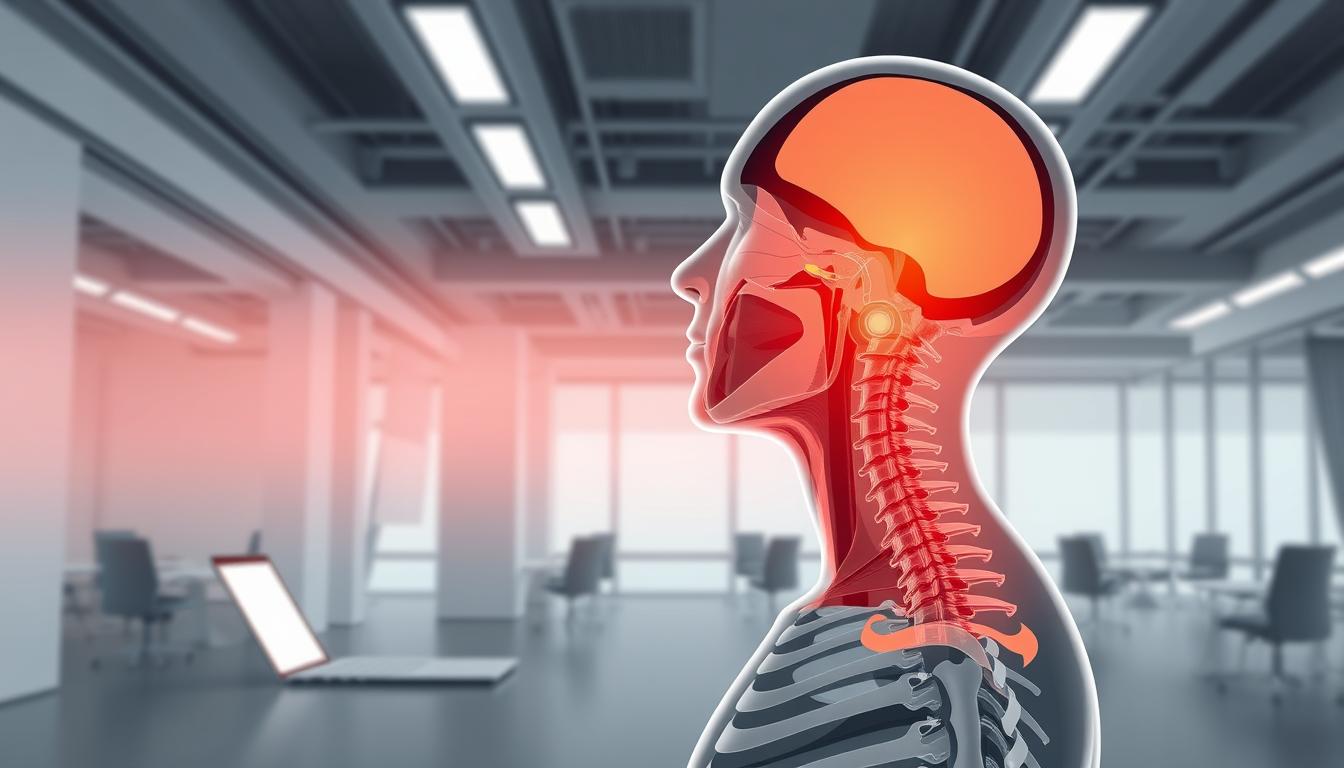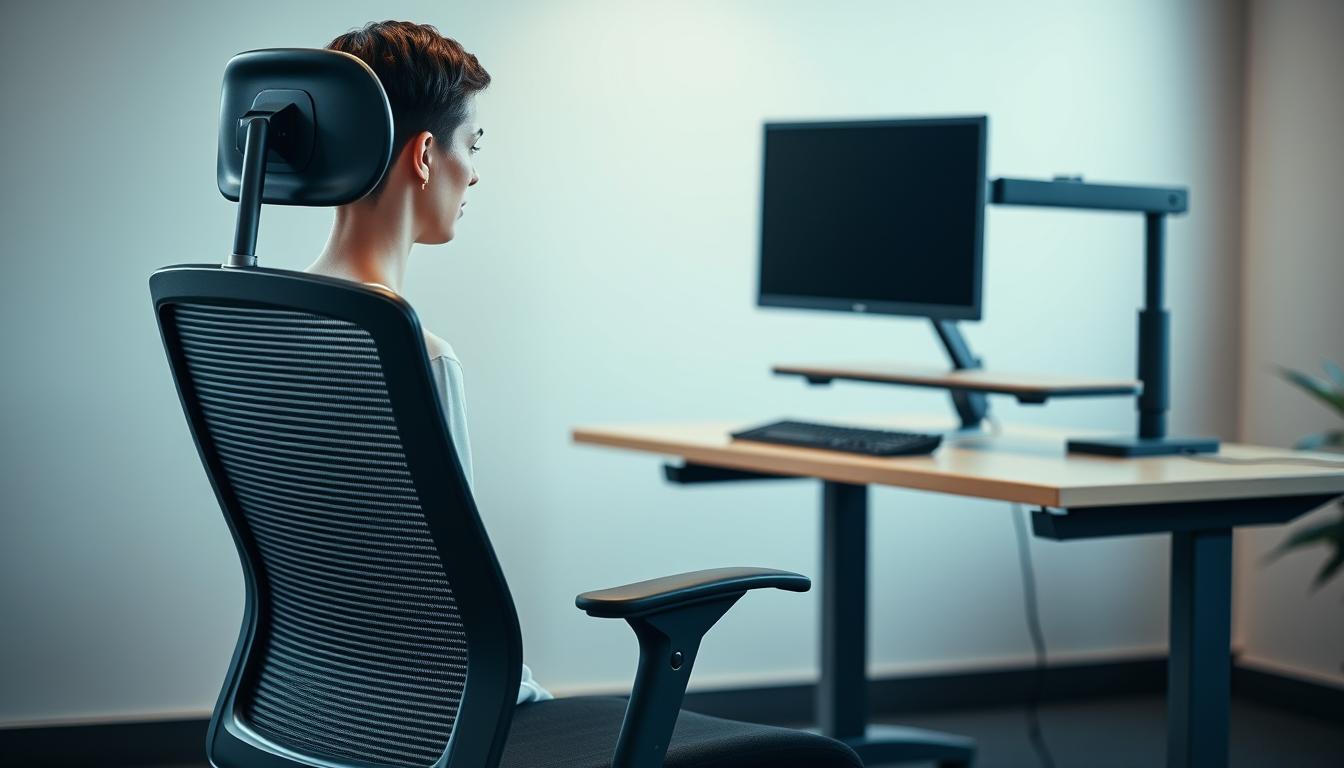In our tech-driven world, the height of our keyboards matters more than ever for neck health. It’s linked to less pain at work. Many workers face neck and shoulder pain, known as WRUQMP. This often comes from bad desk setups, especially with keyboards set too low or high.
Setting your keyboard at the right height isn’t just about feeling good. It’s key to avoiding muscle problems and keeping your neck healthy. By paying attention to this, we can lessen pain and work more comfortably.
Understanding Ergonomics in the Workplace
At work, ergonomics makes sure we’re comfy and efficient, reducing injury risks. It’s about matching the workplace to the worker’s needs. A good office design includes comfy chairs, proper desk height, and well-arranged computer stuff. These elements help employees do their jobs well without hurting themselves.
To make workstations right for each person, ergonomics must be tailored. This customization stops long-term health problems. OSHA suggests that a good workstation setup is key. Using the right ergonomic strategies keeps employees healthy and makes them more productive. So, it’s crucial for companies to focus on setting up offices correctly.
Importance of Proper Keyboard Height
Getting the right keyboard height is key for a good ergonomic posture, which is vital for your long-term health. The correct height helps keep wrists straight and elbows at a nice angle. This helps lower the stress on your neck. Many folks find their keyboard too high or too low, which can lead to bad posture and neck issues. Research points out that having the keyboard at or just below your elbow level is best for a neutral arm position.
To stop neck pain, here are some easy tips for the best keyboard height:
- Adjust the height of your chair so your elbows are at a 90-degree angle when typing.
- Use a footrest to make sure your feet stay flat on the floor. This helps with stability and comfort.
- Pick an ergonomic keyboard that helps with natural hand positioning.
By following these tips, you can boost your comfort and cut down on complaints about muscle pain related to work (WRUQMP). Making these changes helps create a workspace that cares about well-being and efficiency.
How Keyboard Height Influences Neck Health
The link between keyboard height and neck health is very straightforward. Many people don’t pay enough attention to where their keyboard is placed. This oversight can affect their health. A keyboard that’s not aligned right can cause bad posture. This can lead to discomfort. Studies have shown that not having your keyboard at the right height can cause neck pain. It can also lead to other problems with muscles and bones.
Connection Between Keyboard Height and Neck Pain
If your keyboard is too high or too low, it can cause problems. You might end up with your shoulders lifted and your neck stretched out. This can make your neck hurt after a while. To avoid pain in your neck, make sure your keyboard is at the level of your elbows. This helps you keep a good posture and keeps your neck healthy.
Studies Linking Keyboard Position to Musculoskeletal Disorders
Many studies find a link between where your keyboard is and muscle issues. A lot of office workers say they have pain in their upper bodies because their keyboards are not placed right. This shows how important it is to have your workspace set up well. Doing so can help you avoid pain and other health problems down the line.
Adjusting Your Workstation for Optimal Health
Making changes to your workstation can greatly improve comfort and productivity. It’s important to adjust your setup to maintain a good posture and avoid strain on your neck and back. Make sure your keyboard is at the correct height, so your elbows can relax at a 90-degree angle. This is a vital part of having an ergonomic workspace.
It’s necessary to check and tweak your workspace regularly to fit your body’s needs. Customizing your workstation can greatly improve your health. Investing in furniture that can be adjusted, like a desk that can change height, helps your posture and reduces discomfort during the day.
Adding tools and accessories to keep things organized can also lessen the need for unnecessary movements. For instance, use document holders to keep papers at eye level and choose ergonomic chairs for spine support. Adjusting your workstation carefully can lead to better health and more productivity.
Ergonomic Guidelines for Your Keyboard Setup
It’s very important to set up your keyboard in a way that’s comfortable and prevents injuries at work. Making sure your keyboard is placed correctly and at the right height and distance from your body really improves how comfortable your workspace is.
Correct Keyboard Placement
Where you put your keyboard can really affect how your wrists feel. You should place the keyboard at or just below the level of your elbows. This helps you keep your wrists straight and your forearms level with the ground.
By doing this, you help avoid any discomfort or injuries from doing the same motions over and over.
Recommended Height and Distance from the Body
Keeping your keyboard the right distance away from you is key. It should be close enough so you’re not reaching too far, which can make you tired and tense. You want to keep your elbows near your body, with your wrists just above the keyboard.
Experts, like those at the Mayo Clinic, suggest using ergonomic keyboards and wrist supports to make your setup even better.
Impact of Poor Posture on Neck Health
Poor posture greatly affects neck strain, especially in offices. Slouching and extending the neck forward cause discomfort and ergonomic issues. People who often sit this way may feel more neck pain.
Being in one position for too long makes muscles tired and sore. This can lead to long-term pain.

Self-checks help keep the spine straight and ease neck tension. Taking short breaks to move around helps fight the bad effects of poor posture. Paying attention to sitting positions can make a big difference for neck well-being.
- Performing quick stretches throughout the day.
- Adjusting chair height to promote proper alignment.
- Utilizing supportive equipment such as ergonomic chairs and neck supports.
Being active in preventing poor posture helps avoid neck strain. This leads to a more comfortable and healthy work setting.
Long-term Consequences of Neglecting Ergonomics
Ignoring ergonomic rules at work can have serious long-term effects. Employees may experience lasting musculoskeletal disorders, deeply affecting their lives. Problems like chronic pain become common, making it hard to do daily activities well and comfortably.
Studies show that skipping on ergonomics is tied to various health issues. This includes intense neck and back pain that can stick around for years without proper care. These health issues not only cause physical discomfort but also lower work productivity as employees battle ongoing pain.
Ignoring ergonomics can also have big economic impacts on businesses. The cost of healthcare goes up as people need treatment for their pain, which might include therapy, medicines, or surgery for bad cases. But using good ergonomic practices and teaching employees well can improve their health and job satisfaction.
Putting money into ergonomic improvements helps create a healthy and productive work environment. Starting early with the right desk setups can greatly reduce the risk of ergonomic problems. This benefits everyone, employees and bosses alike.
Enhancing Comfort Through Adjustments
Making some simple changes at work can make a big difference in our health and happiness. By setting up our workspace the right way, we can work more efficiently and take better care of our necks. Here are some tips on how to do just that and make our work area healthier.
Examples of Workplace Adjustments for Neck Health
- Sit-Stand Desks: These desks let you switch between sitting and standing. This helps reduce neck strain and encourages good posture.
- Proper Chair Adjustments: Make sure your chair supports your lower back well and can be adjusted to keep your neck properly aligned.
- Placement of Equipment: Keep monitors at eye level and within easy reach. This avoids the need to twist or lean, preventing discomfort.
- Keyboard and Mouse Positioning: Position these tools close to your body to avoid overreaching, which helps keep your shoulders and neck relaxed.
- Frequent Breaks: Taking regular breaks to stretch and move around keeps you flexible and reduces neck tension.
Research shows that people who make these ergonomic changes feel more comfortable and healthier. This leads to doing a better job and enjoying work more.
Conclusion
Understanding how the height of your keyboard affects your neck is very important at work. This article shared that making the right adjustments can really help with neck health. It also improves how comfortable you feel at work. It’s clear that how you place your keyboard can affect neck pain. Getting the right ergonomic tools can make a big difference in health for workers.
It’s important for bosses to check and improve how desks and offices are set up. Making small changes can help keep necks healthy and make everyone work better. When companies pay attention to ergonomic checks, they show they care about their workers. This leads to fewer people missing work and more happiness at the job.
We should keep looking into how changes at work can make us healthier. Both bosses and workers need to make smart choices about their office spaces. Pushing for better ergonomics means a healthier, more comfortable workplace for everyone. This helps create a successful and happy work culture.



